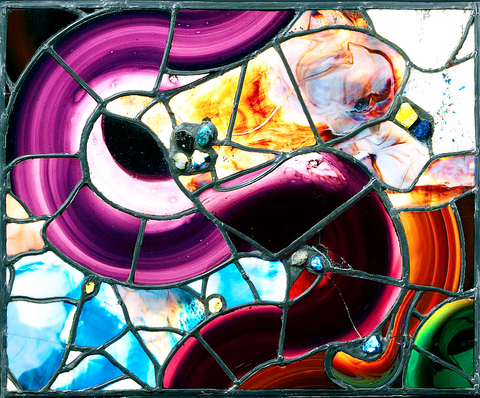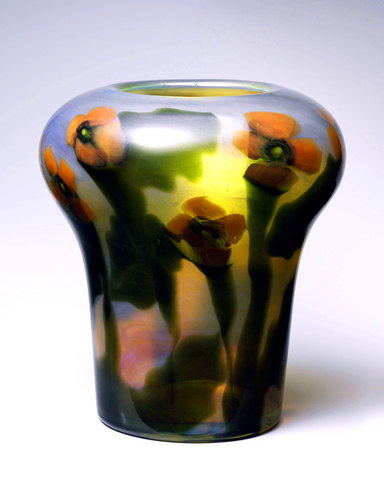Louis Comfort Tiffany and Laurelton Hall: An Artist's Country Estate is the rare exhibition that comes with its own porch. And not just any porch. The Daffodil Terrace temporarily installed at the Metropolitan Museum is larger than many Manhattan apartments. Its tall marble columns are topped with clusters of yellow flowers — daffodils — made of blown glass, the material in which Tiffany achieved his greatest eloquence.
Reassembled here for the first time since Laurelton Hall burned to the ground in 1957, the Daffodil Terrace adds a fitting Temple of Dendur splendor to a strange and lovely exhibition. It has been organized by Alice Cooney Frelinghuysen, the Met's curator of American decorative arts, and presents a series of beautiful objects in search of a ghost.
The Daffodil Terrace once connected the dining room and the gardens at Laurelton Hall, the grand estate that Tiffany built for himself from 1902 to 1905 on 580 extensively landscaped acres overlooking Long Island Sound. It is displayed here in an enormous gallery, along with the stained-glass windows whose trailing wisteria vines brought the garden into the dining room, and the imposing white marble mantel whose three glass mosaic clocks let diners keep track of the time, the day and the month.

PHOTS: NY TIMES NEWS SERVICE
Tiffany was born in 1848, the industrious son of a wealthy founder of the luxury-goods business soon known as Tiffany & Co. He set out to be a painter, touring Europe and the Mediterranean and becoming especially smitten with Orientalism. But he had more facility than originality, as the paintings and watercolors here attest.
An inveterate shopper and cultural scavenger, he must have realized that his love of the exotic — Egyptian, Persian, Asian and North African — might be best expressed in objects, and that these objects could be orchestrated into seductive living environments that no painting could match.
By 1875 Tiffany was spending time in Brooklyn glasshouses, learning the craft. By 1885 he was in the process of melding the English Arts & Crafts notion of the unified interior and the Aesthetic Movement's love of eclecticism into an encompassing vision of his own that presaged Art Nouveau.

He oversaw a succession of companies and factories where as many as 300 artisans produced leaded-glass windows and lamps; favrile-glass vases made by a technique of his own invention; all kinds of objects in enamel and carved wood; and textiles, furniture and rugs. With these resources Tiffany designed lavish multicultural living quarters for the richest, most adventuresome figures of the Gilded Age, including the collectors H.O. and Louisine Havemeyer.
Had Laurelton Hall survived, it would have been Tiffany's ultimate work of art, a monument to a total vision on the scale of Frederic Edwin Church's Persian-Victorian fantasy, Olana, built in the late 1860s high above the Hudson River near Hudson, New York.
In 1918 Tiffany established a foundation to maintain the estate in perpetuity as a house museum and an artist's colony. But the Tiffany Foundation fell on hard times. Although it exists today as a grant-giving body, in 1946 it auctioned off the contents of the house, divided the property into parcels and sold those too. The new owners of the main house rarely visited.
Within days of the fire and at the Tiffany family's request, Hugh F. McKean, an artist who had received a residency at Laurelton Hall in 1930, went to the smoldering ruins and pulled out anything that was relatively intact. Later he and his wife, Jeannette Genius McKean, purchased the remains of Laurelton Hall from salvagers.
These objects, including the Daffodil Terrace, became the core holdings of the Charles Hosmer Morse Museum of American Art in Winter Park, Florida, which the McKeans had established in 1942 and named for Jeanette McKean's grandfather. In 1978 the McKeans gave the Met another Tiffany porch, Laurelton Hall's entrance loggia, which is on permanent view in the Engelhard Court in the museum's American Wing.
The exhibition gives an overwhelming account of Tiffany's talents and interests. His breakfast furniture indicates that in the early 1880s he had thoughts about simple structures and white surfaces that occurred to Charles Rennie Mackintosh and Koloman Moser decades later. There are touches of endearing modesty, like a Steinway upright piano designed by Tiffany and based on a Middle Eastern chest that seems to be inlaid with mother-of-pearl but is actually just ingeniously carved and painted.
There are also examples of Japanese, Chinese and American Indian objects that Tiffany owned, was inspired by and displayed at Laurelton Hall, including two astounding Qing dynasty headdresses made of gilded silver inlaid with brilliant blue kingfish feathers.
But the main attraction is the glass, along with the small, murky photographs of Laurelton Hall's interiors and of Tiffany's city interiors that led up to them. The show encompasses a near-retrospective of stained-glass windows, and the best reveal the different ways Tiffany translated both the gestural and the descriptive powers of painting into an altogether more tactile medium.
While Tiffany is available to us mostly in bits and pieces, objects like these seem to carry whole worlds within them.

Following the rollercoaster ride of 2025, next year is already shaping up to be dramatic. The ongoing constitutional crises and the nine-in-one local elections are already dominating the landscape. The constitutional crises are the ones to lose sleep over. Though much business is still being conducted, crucial items such as next year’s budget, civil servant pensions and the proposed eight-year NT$1.25 trillion (approx US$40 billion) special defense budget are still being contested. There are, however, two glimmers of hope. One is that the legally contested move by five of the eight grand justices on the Constitutional Court’s ad hoc move

Stepping off the busy through-road at Yongan Market Station, lights flashing, horns honking, I turn down a small side street and into the warm embrace of my favorite hole-in-the-wall gem, the Hoi An Banh Mi shop (越南會安麵包), red flags and yellow lanterns waving outside. “Little sister, we were wondering where you’ve been, we haven’t seen you in ages!” the owners call out with a smile. It’s been seven days. The restaurant is run by Huang Jin-chuan (黃錦泉), who is married to a local, and her little sister Eva, who helps out on weekends, having also moved to New Taipei

The Directorate-General of Budget, Accounting and Statistics (DGBAS) told legislators last week that because the Chinese Nationalist Party (KMT) and Taiwan People’s Party (TPP) are continuing to block next year’s budget from passing, the nation could lose 1.5 percent of its GDP growth next year. According to the DGBAS report, officials presented to the legislature, the 2026 budget proposal includes NT$299.2 billion in funding for new projects and funding increases for various government functions. This funding only becomes available when the legislature approves it. The DGBAS estimates that every NT$10 billion in government money not spent shaves 0.05 percent off

Dec. 29 to Jan. 4 Like the Taoist Baode Temple (保德宮) featured in last week’s column, there’s little at first glance to suggest that Taipei’s Independence Presbyterian Church in Xinbeitou (自立長老會新北投教會) has Indigenous roots. One hint is a small sign on the facade reading “Ketagalan Presbyterian Mission Association” — Ketagalan being an collective term for the Pingpu (plains Indigenous) groups who once inhabited much of northern Taiwan. Inside, a display on the back wall introduces the congregation’s founder Pan Shui-tu (潘水土), a member of the Pingpu settlement of Kipatauw, and provides information about the Ketagalan and their early involvement with Christianity. Most